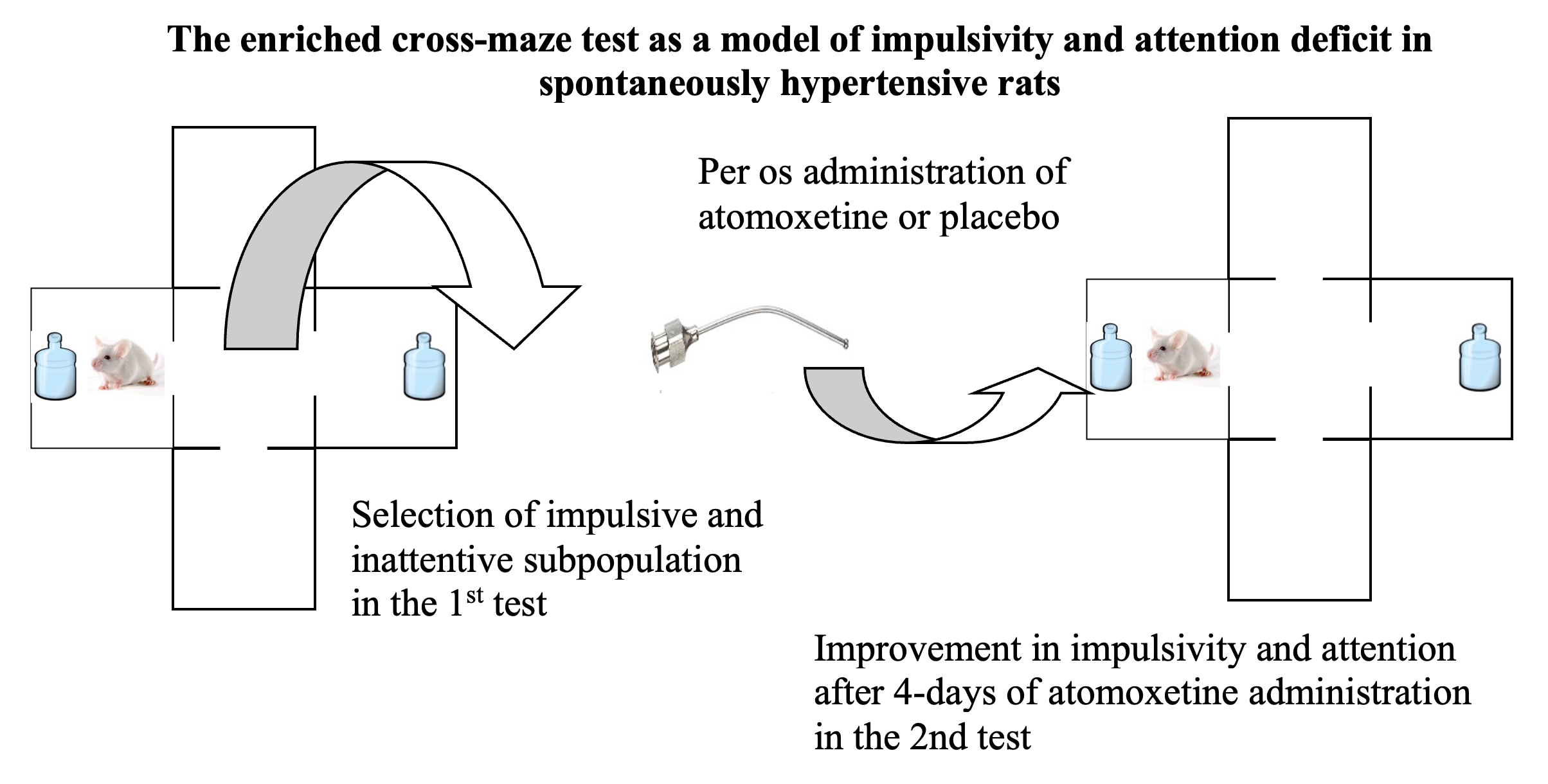The enriched cross-maze test as a model of impulsivity and attention deficit in spontaneously hypertensive rats
DOI:
https://doi.org/10.18413/rrpharmacology.11.533Abstract
Introduction: Attention deficit hyperactivity disorder (ADHD) is one of the problems of modern medicine, which requires development of appropriate treatments using animal models. One of the valid genetic models of ADHD in animals is the spontaneous hypertensive (SH) outbred rats line. Results of the present paper demonstrate heterogeneity among the SH rats line regarding measures of impulsivity and attention deficit obtained by the use of the enriched cross-maze test and assesses the effects of clinically effective anti-ADHD drug atomoxetine.
Materials and Method: 106 adult male SH outbred rats were used. Their exploratory behavior was assessed in the enriched cross-maze test, which provides correlates of impulsivity and attention to enriching objects regardless of overall motor activity. The device consists of 4-arm radial maze, two arms of which contain objects (enriched compartments). Normal non-impulsive and attentive animals exploring the maze usually spend more time in the central compartment before entering the enriched arms and then spend more time in these arms as compared to when in the empty arms.Impulsive and inattentive individuals have the opposite tendency. Atomoxetine (3 mg/kg) was administered orally, once daily for 4 days.
Results and Discussion: Frequency distribution of the impulsivity index had clear bimodal form, which statistically significantly differed from the normal distribution. The outcome indicates existence of subpopulations of individuals with high and low impulsivity. Subpopulation with high impulsivity and low attention to enriching objects (34% of individuals from experiment 1), which are parallel to patients with ADHD, was collected for experiment 2 in which they were treated with atomoxetine or placebo. Subchronic atomoxetine selectively improved impulsivity and attention measures in the second enriched cross-maze test.
Conclusion: The enriched cross-maze test may be useful in neurobiology studies of impulsivity and attention deficit and for screening new drug candidates.
Graphical Abstract

Keywords:
impulsivity, attention deficit, enriched cross-maze, rats with spontaneous hypertension, AtomoxetineReferences
Adriani W, Caprioli A, Granstrem O, Carli M, Laviola G (2003) The spontaneously hypertensive-rat as an animal model of ADHD: evidence for impulsive and non-impulsive subpopulations. Neuroscience & Biobehavioral Reviews 27(7): 639–651. https://doi.org/10.1016/j.neubiorev.2003.08.007 [PubMed]
Al-Menabbawy K, El-Gerzawy A, Ezzat A, Mottawie H (2006) Developmental, behavioral and genetic factors in correlation with attention deficit hyperactivity disorder in E gyptian children. Journal of Medical Sciences 6(4): 569–576. https://doi.org/10.3923/jms.2006.569.576
American Academy of Pediatrics (2000) Clinical practice guideline: diagnosis and evaluation of the child with attention deficit/hyperactivity disorder. Pediatrics 105(5): 1158–1170. https://doi.org/10.1542/peds.105.5.1158[PubMed]
Asherson P, Chen W, Craddock B, Taylor E (2007) Adult attention-deficit hyperactivity disorder: recognition and treatment in general adult psychiatry. British Journal of Psychiatry 190(1): 4–5. https://doi.org/10.1192/bjp.bp.106.026484 [PubMed]
Bizot JC, David S, Trovero F (2011) Effects of atomoxetine, desipramine, d-amphetamine and methylphenidate on impulsivity in juvenile rats, measured in a T-maze procedure. Neuroscience Letters 489(1): 20–24. https://doi.org/10.1016/j.neulet.2010.11.058 [PubMed]
Calzavara MB, Levin R, Medrano WA, Almeida V, Sampaio AP, Barone LC, Frussa-Filho R, Abílio VC (2011) Effects of antipsychotics and amphetamine on social behaviors in spontaneously hypertensive rats. Behavioural Brain Research 225(1): 15–22. https://doi.org/10.1016/j.bbr.2011.06.026 [PubMed]
Davids E, Zhang K, Tarazi FI, Baldessarini RJ (2003) Animal models of attention-deficit hyperactivity disorder. Brain Research Reviews 42(1): 1–21. https://doi.org/10.1016/S0165-0173(02)00274-6 [PubMed]
Johansen EB, Killeen PR, Sagvolden T (2007) Behavioral variability, elimination of responses, and delay-of-reinforcement gradients in SHR and WKY rats. Behavioral and Brain Functions 3: 60. https://doi.org/10.1186/1744-9081-3-60 [PubMed] [PMC]
Kates N (2005) Attention deficit disorder in adults. Management in primary care. Canadian Family Physician 51(1): 53–59. [PubMed] [PMC]
Langen B, Dost R (2011) Comparison of SHR, WKY and Wistar rats in different behavioural animal models: effect of dopamine D1 and alpha2 agonists. ADHD Attention Deficit and Hyperactivity Disorders 3(1): 1–12. https://doi.org/10.1007/s12402-010-0034-y [PubMed]
Mannuzza S, Klein RG, Bessler A, Malloy P, LaPadula M (1993) Adult outcome of hyperactive boys: educational achievement, occupational rank, and psychiatric status. Archives of General Psychiatry 50(7): 565–576. https://doi.org/10.1001/archpsyc.1993.01820190067007 [PubMed]
Meyer AC, Rahman S, Charnigo RJ, Dwoskin LP, Crabbe JC, Bardo MT (2010) Genetics of novelty seeking, amphetamine self-administration and reinstatement using inbred rats. Genes, Brain and Behavior 9(7): 790–798. https://doi.org/10.1111/j.1601-183X.2010.00616.x [PubMed] [PMC]
Naderi F, Heidarie A, Bouron L, Asgari P (2010) The efficacy of play therapy on ADHD, anxiety and social maturity in 8 to 12 years aged clientele children of Ahwaz Metropolitan Counseling Clinics. Journal of Applied Sciences 10(3): 189–195. https://doi.org/10.3923/jas.2010.189.195
Paloyelis Y, Rijsdijk F, Wood AC, Asherson P, Kuntsi J (2010) The genetic association between ADHD symptoms and reading difficulties: The role of inattentiveness and IQ. Journal of Abnormal Child Psychology 38(8): 1083–1095. https://doi.org/10.1007/s10802-010-9429-7 [PubMed] [PMC]
Rico J, Hurtado‐Parrado C, Vasquez-Sepulveda J, Fonseca J, Cardona A (2016) Time in the central area of the elevated plus maze correlates with impulsivity-related measures during an operant task. Universitas Psychologica 15(5): 1–9. https://doi.org/10.11144/Javeriana.upsy15-5.tcae
Sagvolden T, Russell VA, Aase H, Johansen EB, Farshbaf M (2005) Rodent models of attention-deficit/hyperactivity disorder. Biological Psychiatry 57(11): 1239–1247. https://doi.org/10.1016/j.biopsych.2005.02.002 [PubMed]
Salimov RM, Kovalev GI (2012) Enrichment discrimination behavior in spontaneously hypertensive rats. Journal of Behavioral and Brain Science 2(4): 479–484. https://doi.org/10.4236/jbbs.2012.24056
Salimov RM, Kovalev GI (2013) Effect of atomoxetine on behavior of outbred mice in the enrichment discrimination test. Journal of Behavioral and Brain Science 3(2): 210–216. https://doi.org/10.4236/jbbs.2013.32022
Wickens JR, Macfarlane J, Booker C, McNaughton N (2004) Dissociation of hypertension and fixed interval responding in two separate strains of genetically hypertensive rat. Behavioural Brain Research 152(2): 393–401. https://doi.org/10.1016/j.bbr.2003.10.023 [PubMed]
Published
How to Cite
Issue
Section
License
Copyright (c) 2025 Ramiz M. Salimov, Georgy I. Kovalev

This work is licensed under a Creative Commons Attribution 4.0 International License.
 Русский
Русский
 English
English

